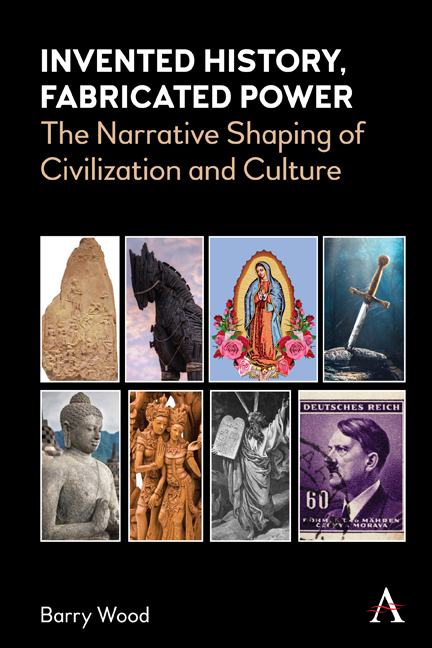Book contents
- Frontmatter
- Dedication
- Contents
- Acknowledgments
- About the Cover
- List of Abbreviations
- Introduction
- Prologue: The Prehistory of Power: Souls Spirits, Deities
- Part One Kings and Emperors
- 1 Divine Kingship in Mesopotamia
- 2 Pharaohs among the Indestructibles
- 3 Kingship among the Hebrews
- 4 The Deification of Roman Emperors
- 5 The Deva-Rajas in India and Southeast Asia
- 6 The Chinese Mandate from Heaven
- 7 The Japanese Imperial Cult
- Part Two Empires before the Common Era
- 8 The Legendary Empire of the Sumerians
- 9 Legendary Empires of Preclassical Greece
- 10 Patriarchs, Exodus, and the Epic of Israel
- 11 Legendary Empires of Ancient India
- 12 The Legendary Founding of Rome
- Part Three Founders
- 13 Moses: The Israelite Lawgiver
- 14 Buddha and Legends of Previous Buddhas
- 15 The Savior Narratives
- 16 Muhammad, the Qur’an, and Islam
- 17 The Virgin Mary through the Centuries
- 18 Tonantzin and Our Lady of Guadalupe
- Part Four Empires of the Common Era
- 19 Narrative Inventions of the Holy Roman Empire
- 20 The Epic of Kings, Alexander the Great, and the Malacca Sultinate
- 21 The Franks, Charlemagne, and the Chansons de Geste
- 22 The Legendary Kingdom of King Arthur
- 23 Ethiopian Kings and the Ark of the Covenant
- 24 Narratives of the Virgin Queen
- Part Five Ideologies
- 25 Discovery: The European Narrative of Power
- 26 Epics of the Portuguese Seaborne Empire
- 27 Dekanawida and the Iroquois League
- 28 The New England Canaan of the Puritans
- 29 The Marxist Classless Society
- 30 Adolph Hitler: Narratives of Aryans and Jews
- Epilogue: A Clash of Narratives
- Bibliography
- Index
- About the Author
9 - Legendary Empires of Preclassical Greece
Published online by Cambridge University Press: 15 December 2020
- Frontmatter
- Dedication
- Contents
- Acknowledgments
- About the Cover
- List of Abbreviations
- Introduction
- Prologue: The Prehistory of Power: Souls Spirits, Deities
- Part One Kings and Emperors
- 1 Divine Kingship in Mesopotamia
- 2 Pharaohs among the Indestructibles
- 3 Kingship among the Hebrews
- 4 The Deification of Roman Emperors
- 5 The Deva-Rajas in India and Southeast Asia
- 6 The Chinese Mandate from Heaven
- 7 The Japanese Imperial Cult
- Part Two Empires before the Common Era
- 8 The Legendary Empire of the Sumerians
- 9 Legendary Empires of Preclassical Greece
- 10 Patriarchs, Exodus, and the Epic of Israel
- 11 Legendary Empires of Ancient India
- 12 The Legendary Founding of Rome
- Part Three Founders
- 13 Moses: The Israelite Lawgiver
- 14 Buddha and Legends of Previous Buddhas
- 15 The Savior Narratives
- 16 Muhammad, the Qur’an, and Islam
- 17 The Virgin Mary through the Centuries
- 18 Tonantzin and Our Lady of Guadalupe
- Part Four Empires of the Common Era
- 19 Narrative Inventions of the Holy Roman Empire
- 20 The Epic of Kings, Alexander the Great, and the Malacca Sultinate
- 21 The Franks, Charlemagne, and the Chansons de Geste
- 22 The Legendary Kingdom of King Arthur
- 23 Ethiopian Kings and the Ark of the Covenant
- 24 Narratives of the Virgin Queen
- Part Five Ideologies
- 25 Discovery: The European Narrative of Power
- 26 Epics of the Portuguese Seaborne Empire
- 27 Dekanawida and the Iroquois League
- 28 The New England Canaan of the Puritans
- 29 The Marxist Classless Society
- 30 Adolph Hitler: Narratives of Aryans and Jews
- Epilogue: A Clash of Narratives
- Bibliography
- Index
- About the Author
Summary
Farming and animal husbandry appears to have reached the shores of the Aegean Sea and mainland Greece by 7,500 BCE, traveling from agricultural origins in West Asia at a pace that brought them to Crete by 6000 BCE and all of Europe by 4,000 BCE (Cavalli-Storza and Bodmer 1994,107–108). To Crete migrant farmers brought an array of domesticated plants and animals. The evidence suggests they were Indo-European speakers from Anatolia, the earliest location where historical records of this huge language family have been found, principally in the thousands of clay tablets of the Hittites (Mallory 1989, 24–25). According to Colin Renfrew (1987; 1989) Anatolia may be the original homeland of the Indo-Europeans, but the competing Kurgan theory by Maria Gimbutas (1985) locates it to the northeast of the Black Sea in the Russian steppes, in which case Anatolia was a way station and its migration to Crete may have been the first Indo-European entry into Europe.
Over the next three millennia, a village population grew in Crete and domestication expanded to include indigenous olives and grapes. By 3000 BCE, a complex society organized around a kingship had emerged at Knossos (Pfeiffer 1977, 278–79). Zeus, the supreme god of the Greeks, is said to have been born and raised in Crete; his abduction of Europa, the eponymous ancestress of an entire continent, provides an emblem for Crete as the earliest monumental culture of Europe (Kofou 2000, 20–26). Everything we know about ancient Crete is mired in myth. The coupling of Zeus and Europa led to the birth of King Minos and thus the Minoans, but King Minos who married Pasiphae, the daughter of the sun god Helios, is said to have unified a hundred cities from his citadel at Knossus. These stories provide an example of narrative anachronism: Minos is both an original founder of Knossus and centuries later an imperial king known on the mainland. Whether Minos was a historic ruler fictionalized or a complete fiction, he was the first divine king of Europe by virtue of the myth of his direct descent from Zeus.
- Type
- Chapter
- Information
- Invented History, Fabricated PowerThe Narratives Shaping Civilization and Culture, pp. 101 - 110Publisher: Anthem PressPrint publication year: 2020



